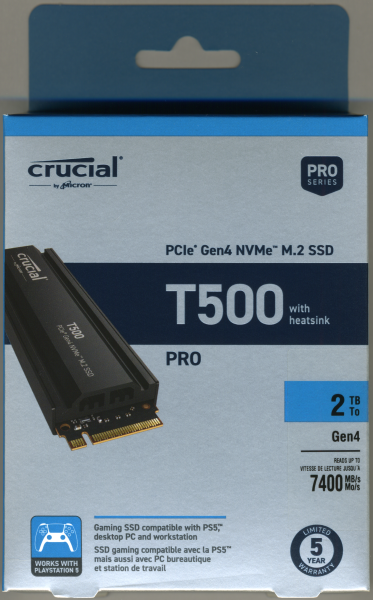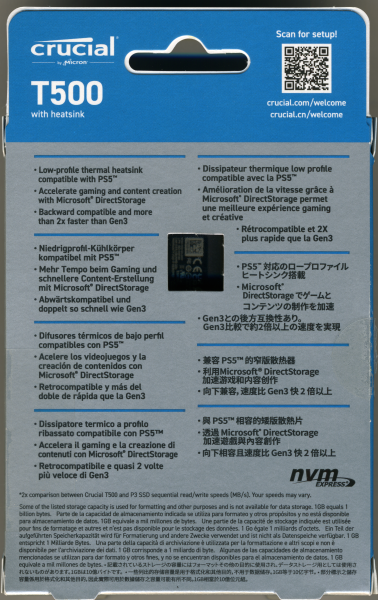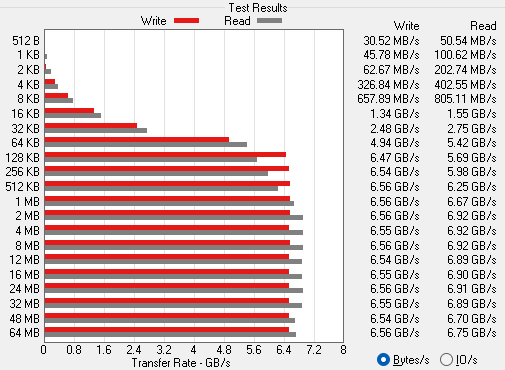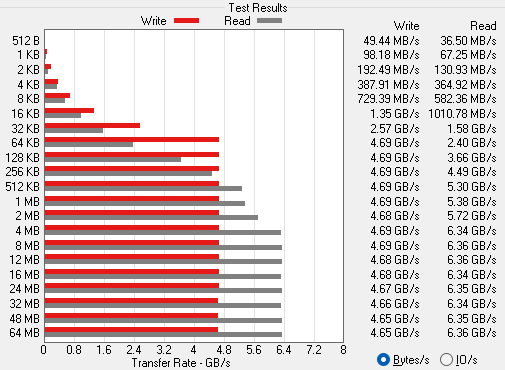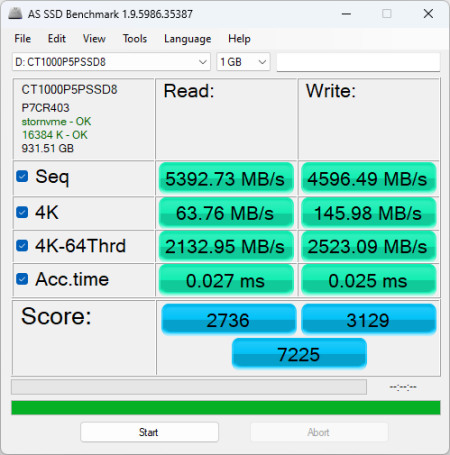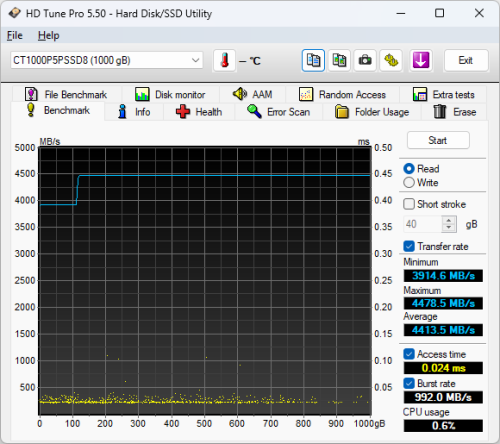

Model: Crucial T500 2TB PCIe Gen4 NVMe Solid State Drive
Manufacturer: Crucial
Provided By: Crucial
Crucial is a global brand of Micron Technology, Inc., one of the largest memory and flash storage manufacturers in the world. The company's product lineup includes award-winning solid state drives (SSDs) and computer memory upgrades (DRAM) for more than 50,000 systems. These products have been qualified and approved by major original equipment manufacturers and every single module has been rigorously tested at the component and module level. Each SSD also undergoes over a thousand hours of prerelease validation testing and hundreds of qualification tests to ensure optimal reliability and performance.
This past fall, Crucial introduced its latest Gen4 NVMe SSD, the T500. Designed for console and PC gamers, photo and video editors and content creators, this M.2 form factor drive is powered by Phison's new PS5025-E25 controller and is available with up to 2TB of Micron's industry-leading 232-layer 3D TLC NAND flash. The T500 is also available with or without an integrated, premium heatsink and is equipped with an ultra-fast PCIe Gen 4.0 x4 NVMe 2.0 interface to deliver up to 7,400 MB/s read and 7,000 MB/s write speeds. To top it all off, the drive supports Microsoft’s DirectStorage API software technology for faster game load times, quicker texture renders and reduced CPU utilization.
The T500 is available in 500GB, 1TB and 2TB capacities. For this review, Crucial sent us the 2TB, heatsink-equipped version of the drive, which is capable of delivering up to 7,400 MB/s sequential read and 7,000 MB/s sequential write speeds as well as up to 1,180K random read and 1,440K random write IOPS.
| Crucial T500 2TB PCIe Gen4 NVMe Solid State Drive | |||||||||||||||||||||||||||
General Specifications
Performance
Reliability
Environmental
Other Features
|
Needless to say, this is only a taste of what the T500 has to offer. To give you an idea of what to expect, we'll take a closer look at Crucial's latest PCIe Gen4 SSD and then see how well it performs. Does the T500 have what it takes? Can it deliver the performance and features that we've come to expect from Crucial? Keep reading as we find out.
The T500 comes in a small, blue and gray box. Along with a picture of the drive, the packaging advertises a number of its key features including its 2TB capacity, support for PCIe Gen4 NVMe technology, maximum read speed, 5 year warranty and compatibility with the PS5. Inside, you'll find the T500 as well as a small guide with information on where you can get additional help and download the migration and cloning software.

Physical Features:
The T500 uses the 2280 form factor for M.2 (NGFF) SSDs. The heatsink-equipped version measures 80.01 x 23.37 x 9.65mm and tips the scales at around 35g. The drive also has an "M key" edge connector which provides PCIe SSDs with up to 4x lanes of bandwidth.

This heatsink wraps entirely around the drive and is held together using small, circular clips instead of screws. While this ensures a solid fit, it also adds to the overall width of the drive. Compared to the heatsink-less T500, this one is about 1mm wider. This doesn't sound like much. However, you will want to make sure that the card doesn't hit a PCI slot or any of the other components on your motherboard. With the heatsink's increased height (about 8mm), you'll also want to be careful that it doesn't interfere with your video card if your motherboard's M.2 slot is below it. That being said, the heatsink-equipped T500 will fit fine in the PlayStation 5 without any problems.
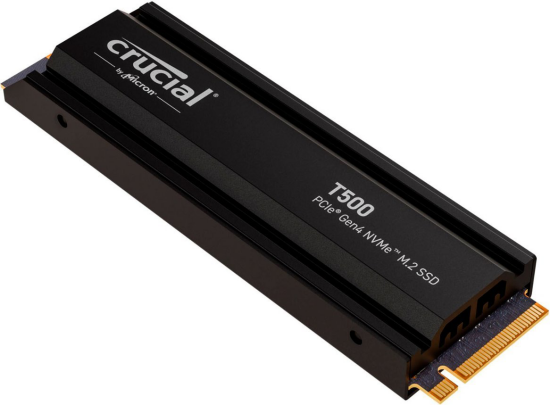
The T500 is one of the first drives to use Phison's PS5025-E25 controller. Manufactured using TSMC 12nm process technology, this PCIe 4.0 x4 NVMe 2.0 controller is powered by a dual-core ARM Cortex R5 processor with CoXProcessor technology and has 4 NAND channels with 16 chip enables (CE) per channel. The E25 also offers support for up to 4TB of 3D TLC/QLC NAND flash and features end-to-end data path protection, hardware-based encryption and Phison's fifth generation low-density parity-check (LDPC) and RAID ECC algorithms for improved drive reliability.

For the 2TB version of the heatsink equipped T500, Crucial opted to use Micron's 232-layer (B58R) 3D TLC NAND flash. If you'd remove the heatsink, you'd see that there are two 1TB NAND flash packages on the top of the PCB. The drive also has a single 2GB Micron LPDDR4 DRAM chip that is used for caching.
The test system used in this review is equipped with an AMD Ryzen 9 7900x CPU, Gigabyte B650E AORUS master motherboard, 32GB (16GB x 2) of Corsair Vengeance 5200MT/s DDR5 memory, Samsung 990 Pro 2TB SSD and a GIGABYTE GeForce GTX 1060 WINDFORCE OC 6G graphics card. For the operating system, I used the latest version of Windows 11.
To test the performance of Crucial's T500 SSD, I ran a series of benchmarks using CrystalDiskMark, ATTO Disk Benchmark, AS SSD, HD Tune Pro, Anvil's Storage Utilities, Iometer and PCMark. For comparison, I've also included test results from the ADATA SE920, ADATA LEGEND 970, Crucial T700, Solidigm P44 Pro, Samsung 990 PRO, ADATA LEGEND 960, Crucial P3 Plus, SK hynix Platinum P41, Silicon Power XS70, WD_BLACK SN770, ADATA XPG ATOM 50, ADATA XPG GAMMIX S70 Blade, Crucial P5 Plus, Plextor M10PY, ADATA XPG GAMMIX S70, Sabrent Rocket 4 Plus, WD_BLACK SN850, Silicon Power US70, ADATA XPG GAMMIX S50 Lite, Crucial X10 Pro, Crucial X9 Pro, ADATA Elite SE880, Kingston XS2000, ADATA XPG ATOM 30, Samsung 980, Silicon-Power UD70, Crucial P2, SK hynix Gold P31 and Crucial P5.
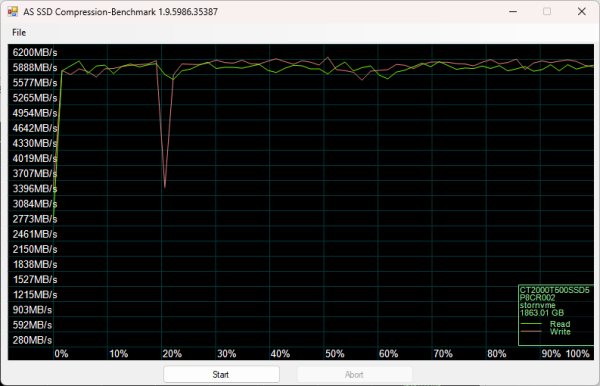
As I mentioned earlier, the T500 uses Phison's PS5025-E25 controller chip. Looking at the screenshot above, you can see that it performs equally well with both incompressible (0%) and compressible (100%) data.
CrystalDiskMark 8.0.4:
First, I ran a few quick tests using CrystalDiskMark. This benchmark measures the performance of a storage device by testing its sequential and random read and write speeds. For this test, we're using the peak and real world profiles.
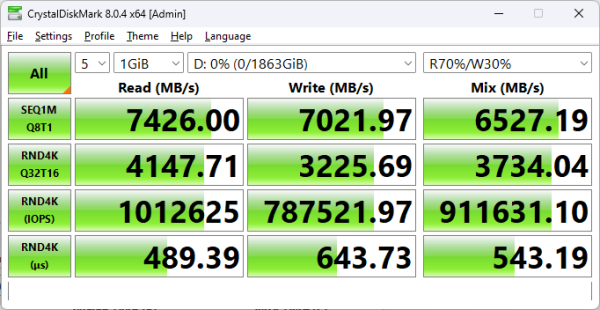
According to Crucial, the 2TB T500 is capable of reading at 7,400 MB/s and writing at 7,000 MB/s. As you can see, the drive had no problems reaching these speeds in CrystalDiskMark's sequential read and write tests.
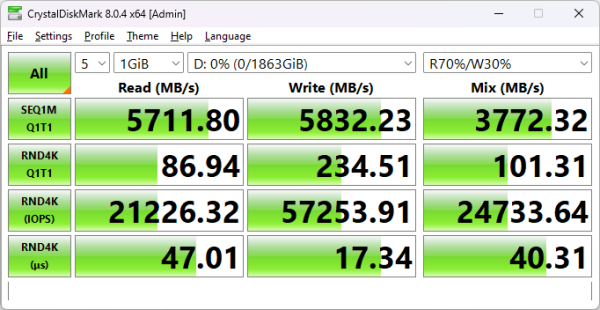
As you'd expect, the T500 wasn't as fast when tested with the "real world" profile which uses a single thread and a much lower queue depth. Nevertheless, it was still able to read at 5,711 MB/s and write at more than 5,800 MB/s.
ATTO Disk Benchmark 4.01:
I also used ATTO Disk Benchmark to test the T500's sequential read and write speeds. The tests are run using blocks ranging in size from 512B to 64 MB and the total length set to 256MB.
When tested with ATTO, the T500's read speeds topped out at about 6.92 GB/s and its write speeds at 6.56 GB/s.
AS SSD:
AS SSD is a benchmark designed specifically for solid state drives. The application contains five synthetic tests used to determine the sequential and random read and write performance of a drive.
AS SSD also includes a copy benchmark. This test copies an ISO (two large files), program (many small files) and game (small and large files), returning the speed and duration of each.
HD Tune Pro 5.75:
Next, I ran a series of tests using HD Tune Pro. This hard disk utility measures a drive's performance by testing its sequential read and write speeds as well as its access time, burst rate and CPU usage. For this review, I'm also going to use it to benchmark the T500's random read and write speeds, random access times and the number of operations per second.
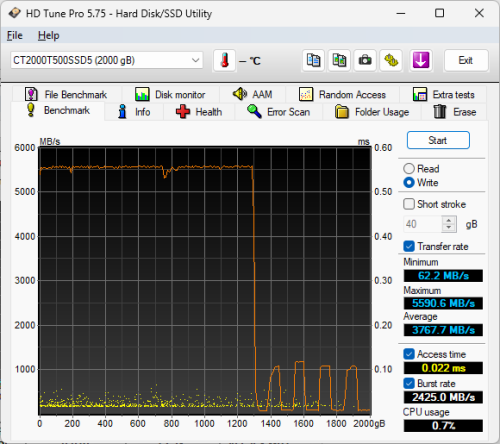 Crucial T500 with Heatsink 1TB - Write Benchmark |
 Crucial P5 Plus with Heatsink 1TB - Write Benchmark |
The T500 performed fairly well when benchmarked with HD Tune. The drive had average read and write speeds of 5606.4 MB/s and 3767.7 MB/s, respectively.
 Crucial T500 with Heatsink 1TB - Random Access Read |
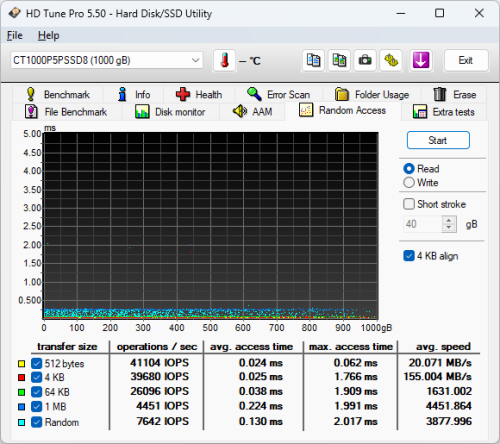 Crucial P5 Plus with Heatsink 1TB - Random Access Read |
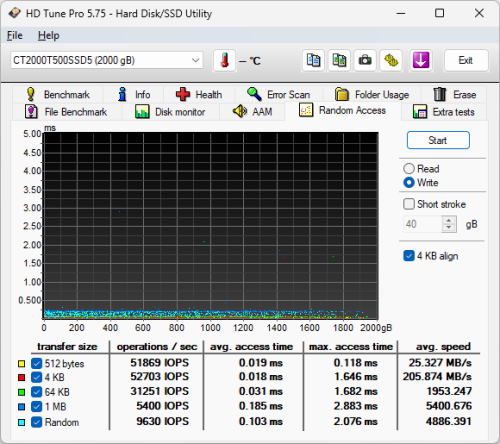 Crucial T500 with Heatsink 1TB - Random Access Write |
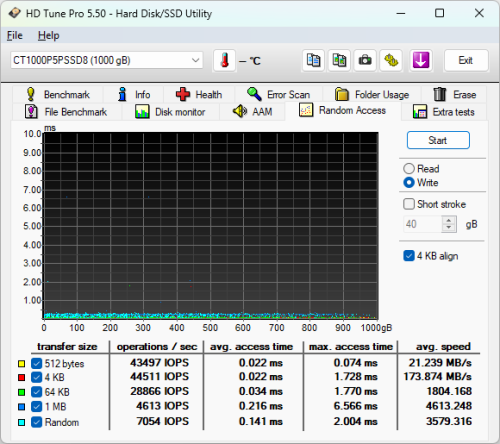 Crucial P5 Plus with Heatsink 1TB - Random Access Write |
When reading 4KB blocks, the T500 reached 47,998 IOPS and had an average speed of 187.494 MB/s. The drive was even faster when writing, reaching 52,703 IOPS with an average speed of 205.874 MB/s.
Anvil's Storage Utilities:
Anvil's Storage Utilities is another benchmark designed with SSDs in mind. The standard storage benchmark measures a drive's performance by testing its transfer speeds, access times and IOPS.
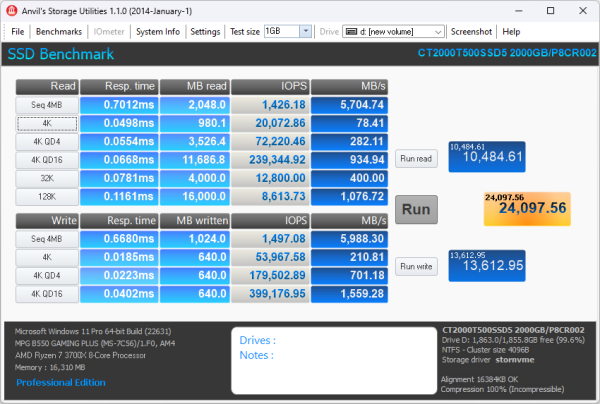
Iometer:
Lastly, I ran a series of tests using Iometer. This tool can be configured to benchmark a number of things. In this case, I used it to measure the T500's read and write speeds and the number of operations per second. The tests were run using random bytes and a queue depth of 3.

The T500's performance was very similar to what we saw in our other tests. The drive was able to read at 7035.30 MB/s and write at 6696.23 MB/s.

The T500 also performed very well when doing random reads and writes. In our tests, the drive was able to read at 428.03 MB/s and write at a blazing 731.46 MB/s.

According to Crucial, the 2TB T500 is capable of 1,180K IOPS when reading and 1,440K IOPS when writing 4K blocks. With two threads and a queue depth of three, the drive reached 109,575 random read IOPS and 187,254 random write IOPS.

As with most drives, the T500 performed better with more threads and at higher queue depths. With sixteen threads and the queue depth set to 32, it reached 975,254 random read IOPS and 762,230 random write IOPS.
PCMark 8 - Storage Test:
PCMark 8 is a complete benchmark for Windows. It includes five benchmark tests, each designed around a specific scenario. The storage benchmark measures drive performance using real-world traces recorded from Adobe Creative Suite, Microsoft Office and a selection of popular games.

PCMark 8 also includes a consistency test which measures the performance consistency and degradation tendency of a storage system. The test reports the performance level at the start, the degraded steady-state and the recovered state as well as the number of iterations required to reach the degraded state and the recovered state. For this test, we are focusing on the Adobe Photoshop (Heavy) trace and will look at both the bandwidth and latency of the drive


The T500 didn't do as well as some of the other drives in this test. During the degradation and steady phases, its bandwidth dropped below 500 MB/s. The T500's performance did increase somewhat during the last recovery phase. However, with it topping out at only 625 MB/s, it lagged behind the Samsung 990 PRO, ADATA LEGEND 960 and Crucial P5 Plus.
PCMark 10 - Full System Drive Benchmark:
PCMark 10's Full System Drive Benchmark uses a wide-ranging set of real-world traces from popular applications and common tasks to fully test the performance of the fastest modern drives. This benchmark produces an overall score as a measure of drive performance. Comparing devices is as simple as comparing scores. The tests also measure and report the bandwidth and average access time performance for the drive.
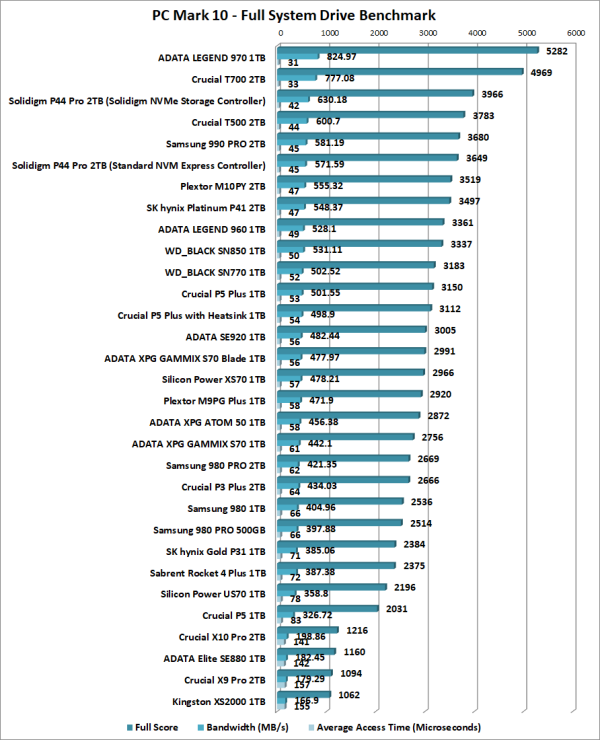
The T500 did very well in PCMark 10's Full System Drive Benchmark. While not nearly as fast as the T700 and its PCIe 5.0 interface, it performed better than the Samsung 990 PRO, Plextor M10PY and SK hynix Platinum P41.
Temperature:
While PCIe SSDs like the T500 offer impressive performance, they also generate a good amount of heat. To keep themselves from overheating, most SSDs have implemented a mechanism called thermal throttling which automatically reduces a drive's performance when it reaches a certain temperature.
If you're someone looking to get the most out of your SSD, this is something that you don't want to happen. As a result, companies like Crucial have begun to equip many of their PCIe SSDs with a heatsink.

The T500's heatsink did a great job of keeping it cool. At idle, the T500's temperature averaged about 30 ºC. Under heavy loads, it reached temperatures as high as 58 ºC when reading and 60 ºC when writing. These temperatures had no impact on the drive's performance. No matter how hard I pushed it, the T500 did not throttle its read or write speeds in any noticeable way.
Final Thoughts:
The Crucial T500 is an excellent choice for the gamer or creative professional looking for a fast, yet affordable, Gen4 NVMe SSD for their computer or PlayStation 5 gaming console. Available with or without an integrated heatsink, this M.2 form factor drive is powered by Phison's PS5025-E25 controller and is available with up to 2TB of Micron's industry-leading 232-layer 3D TLC NAND flash. Combine this with a large DRAM cache and a PCIe Gen4 x4 NVMe 2.0 interface and you have drive that is more than 2x faster than Gen3 NVMe SSDs. The 2TB T500 flew through our sequential transfer rate tests, reading at speeds as high as 7,426 MB/s and writing at more than 7,000 MB/s. The drive also did very well in our random write tests, producing more than 187,000 IOPS at low queue depths.
The T500 is available now in 500GB, 1TB and 2TB capacities with prices for the heatsink-less version ranging from $72 to $149 on Amazon.com. If you want the heatsink, expect to pay about $10 to $20 more.

Highs:
- Available in 500GB, 1TB and 2TB capacities
- PCIe 4.0 x4 interface with NVMe protocol
- Phison PS5025-E25 controller
- Equipped with Micron 232-Layer B58R 3D TLC NAND
- Excellent sequential and random read and write performance
- Small M.2 2280 form factor
- Large DRAM cache
- Full hardware-based encryption
- Available with or without heatsink
- Optimized for Microsoft’s DirectStorage API
- Works with PlayStation 5
- Includes Acronis True Image cloning software
- Reasonably priced
- 5 year warranty
Lows:
- Write speed drops when SLC cache is full
